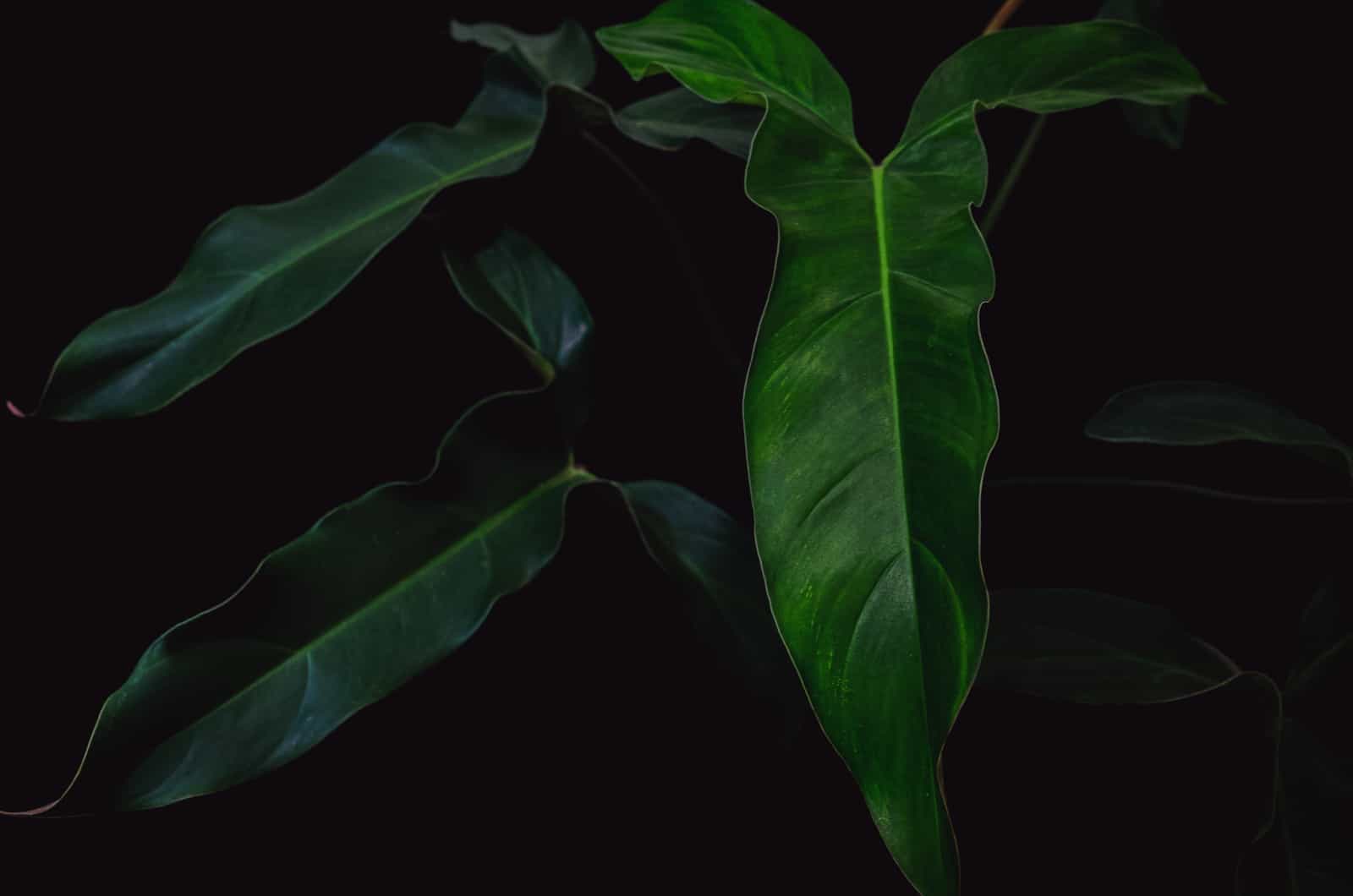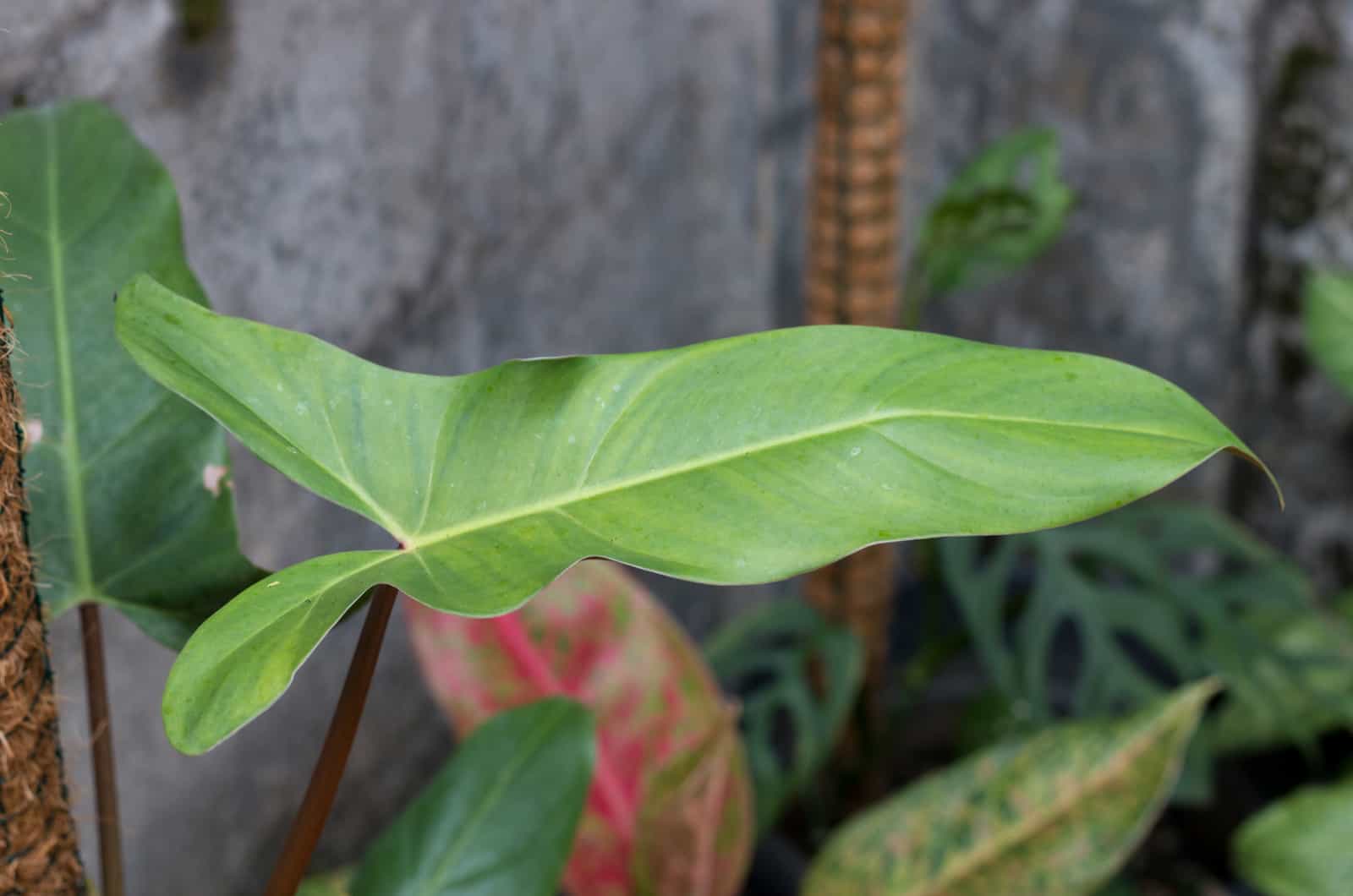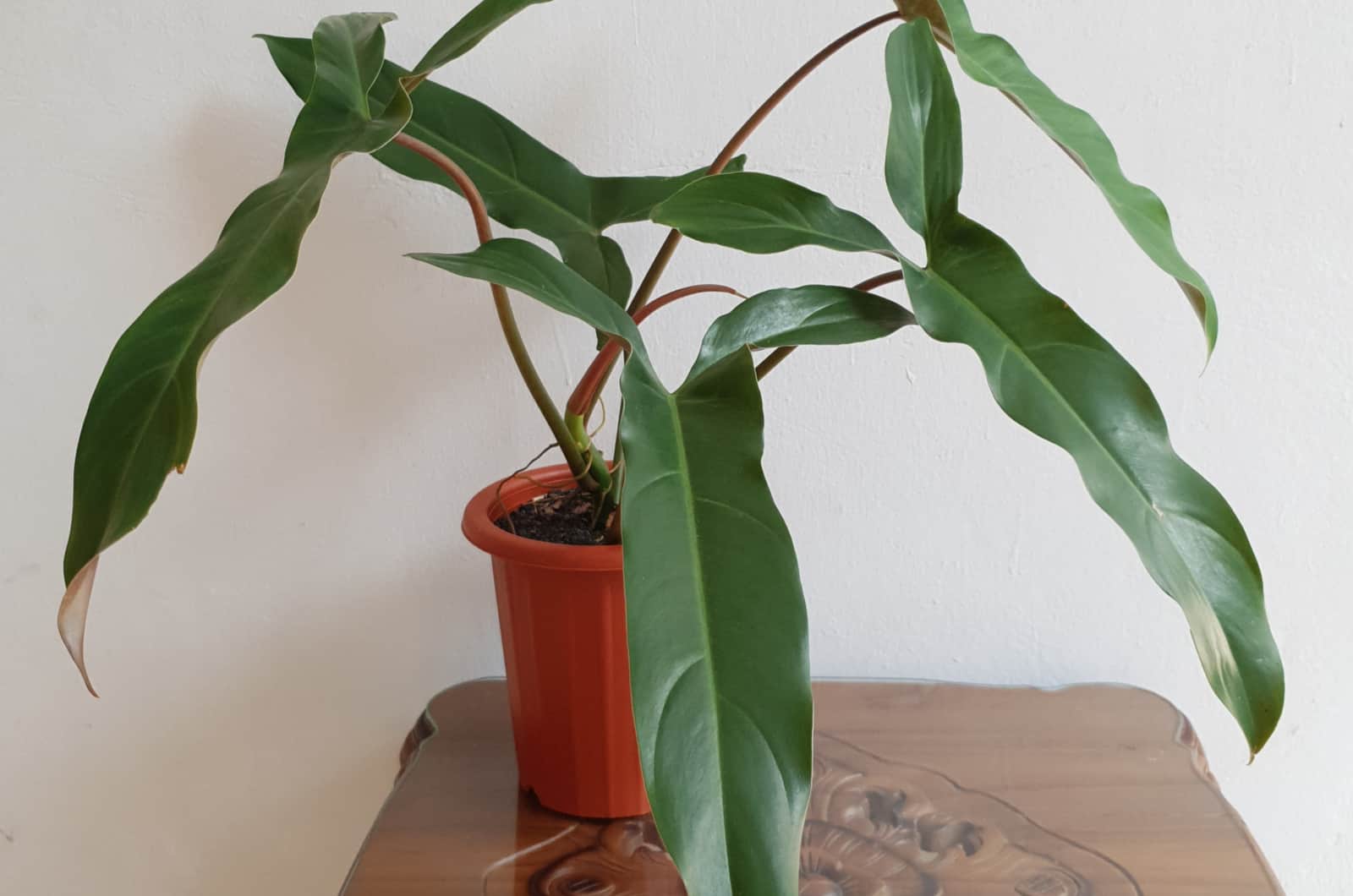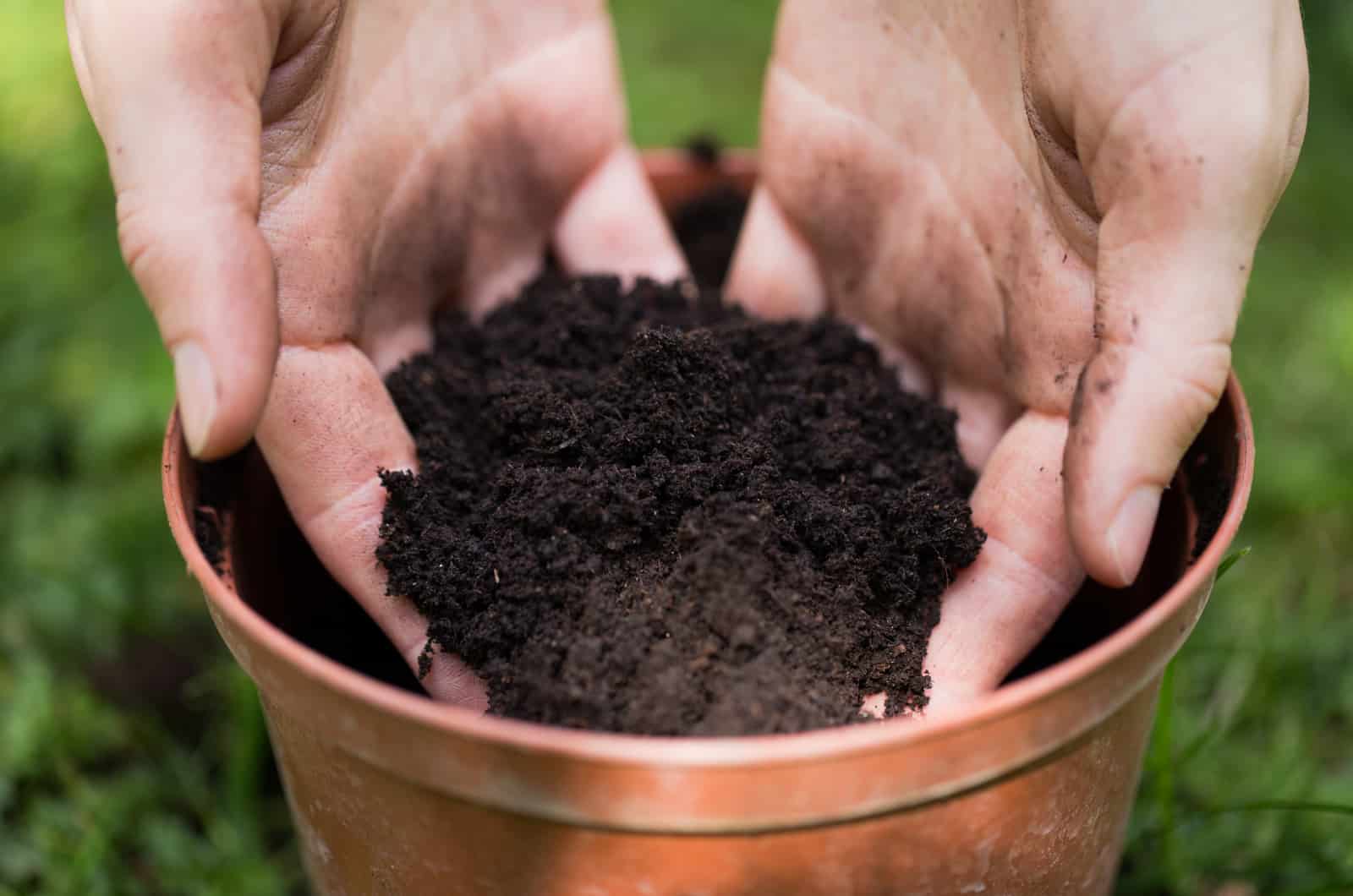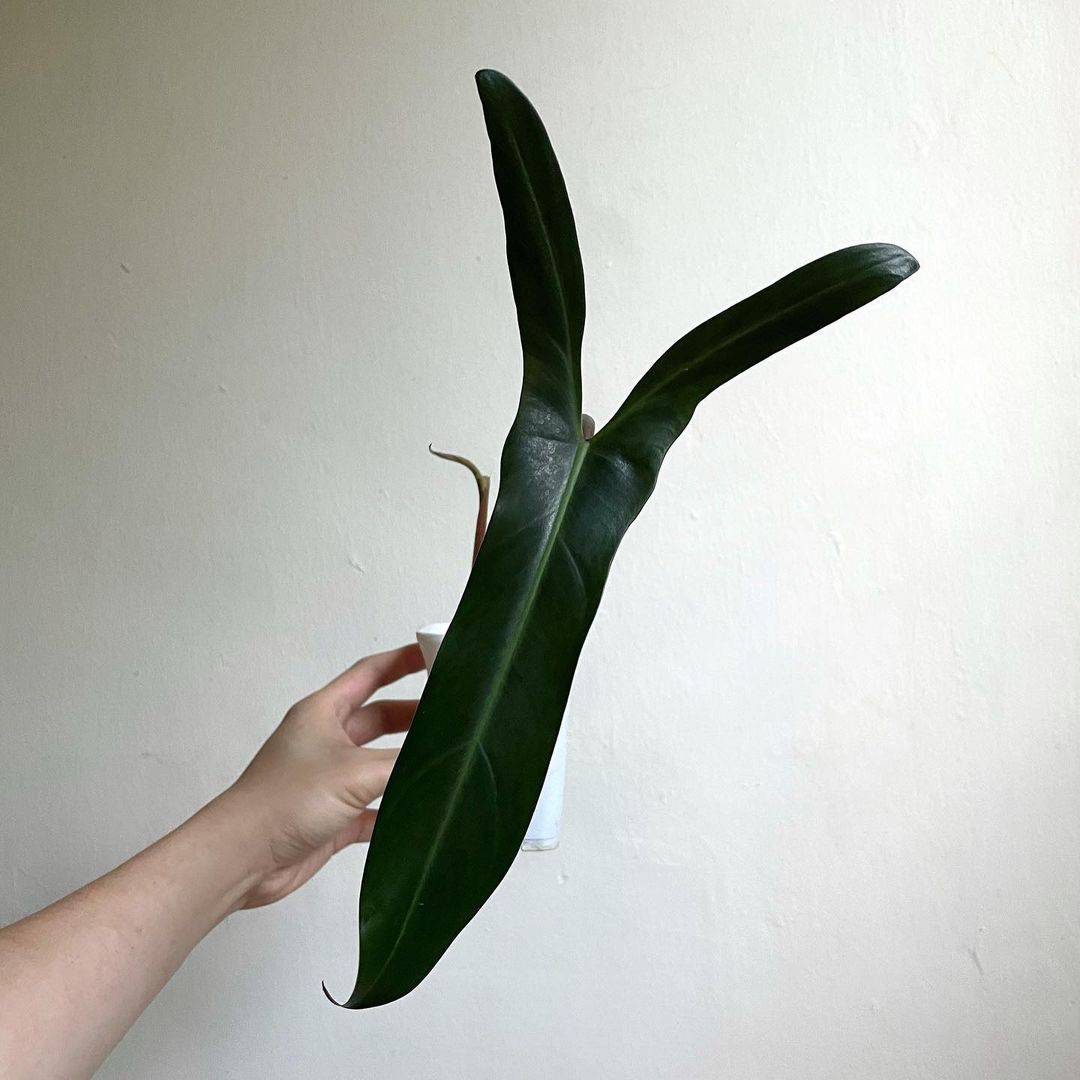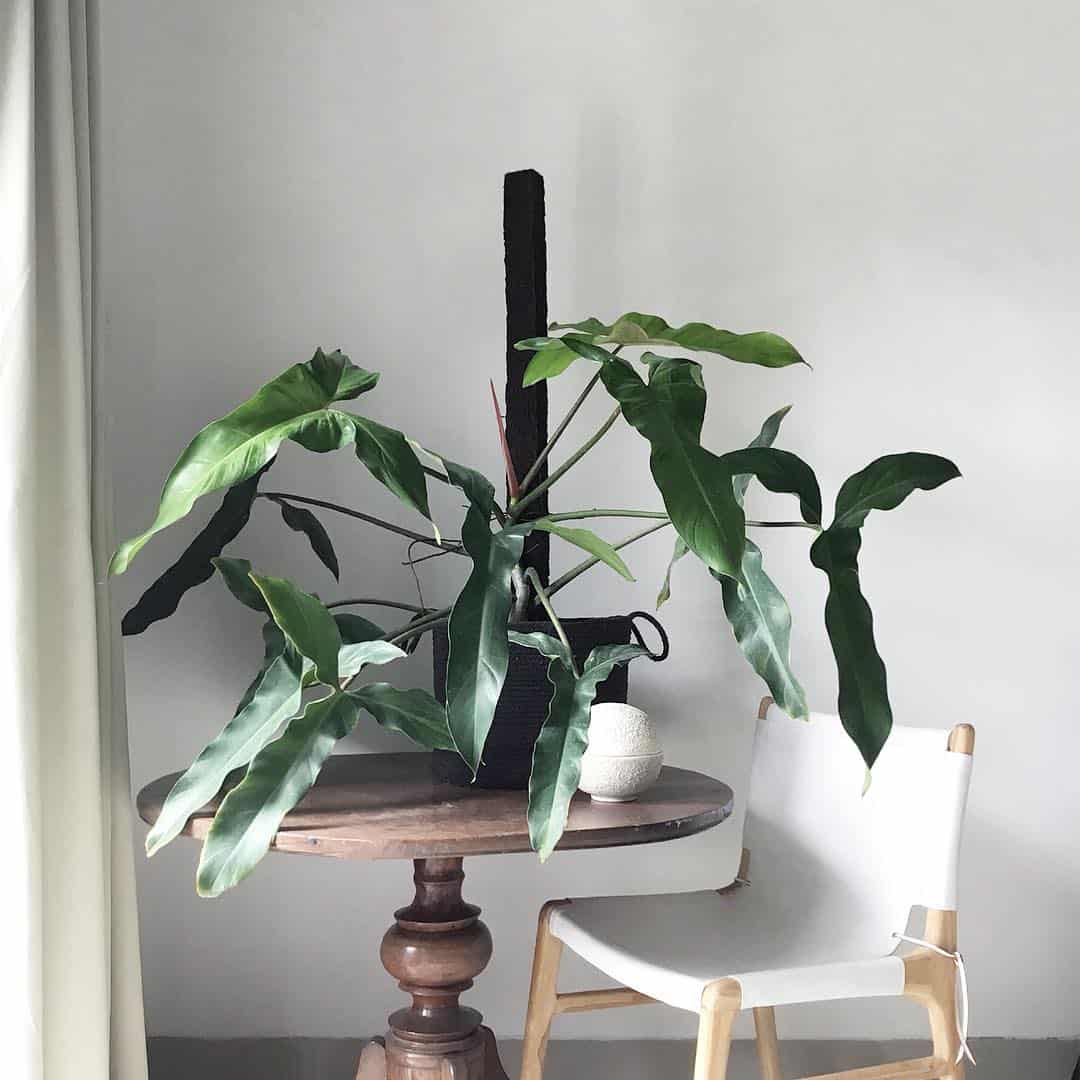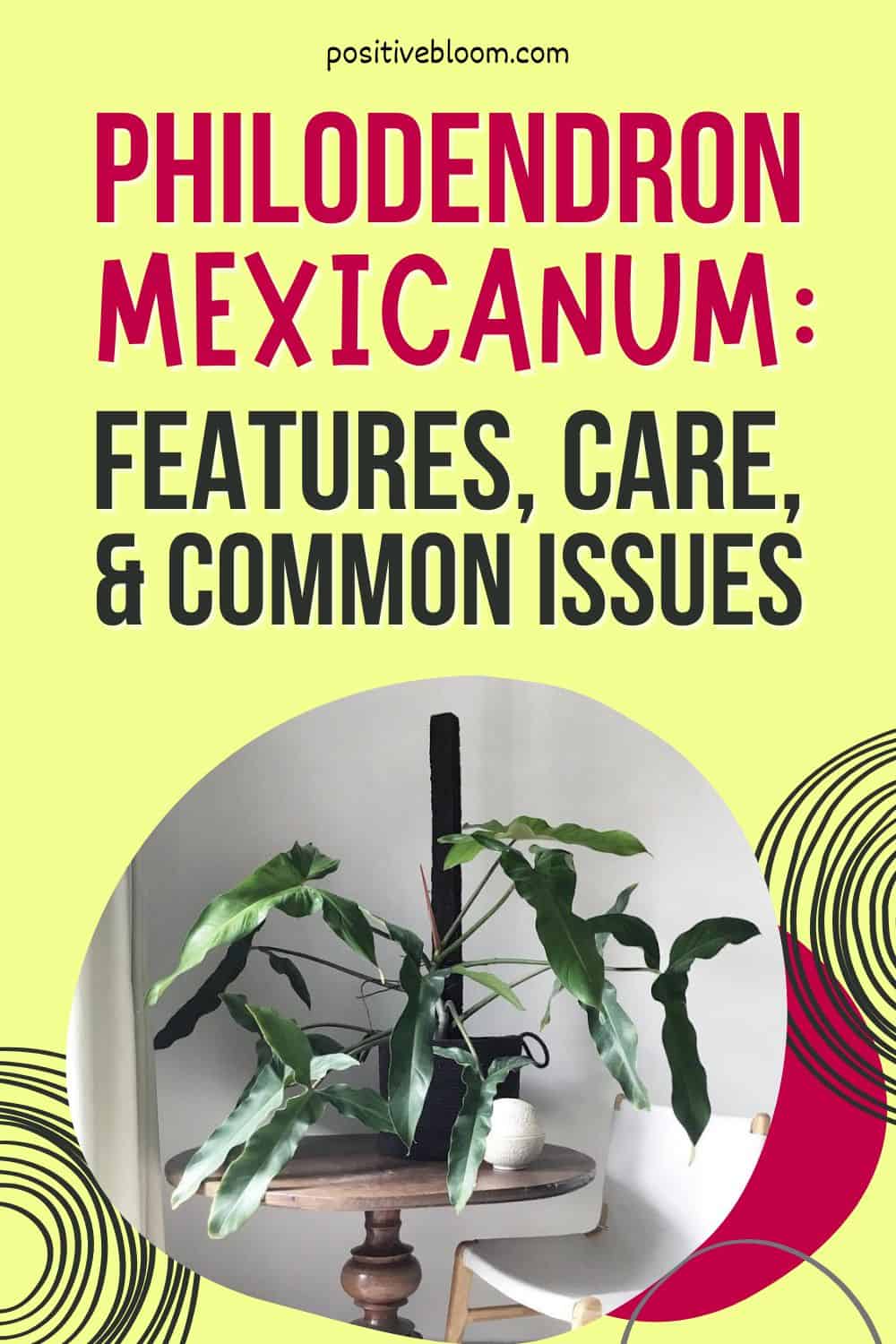When you ask most plant growers which houseplant they would recommend growing, the answer is undoubtedly: “Grow Philodendrons”.
There are over 500 species in the Philodendron genus.
This article will be about one species, with an interesting name- the fascinating Philodendron Mexicanum. It comes from the Araceae family and will make a great addition to your home decor.
This plant is exotic, easy to grow, and perfect indoors, especially if you like climbers. Above all, it looks fantastic, and you can grow it in a house, apartment, office, and even outdoors.
Before we move on, here’s some basic info.
[table id=124 /]Let’s start!
What Does A Philodendron Mexicanum Look Like?
Thank you, Mexico! I think this is one of those plants that can’t go unnoticed. I’m sure that if you get the chance to see a couple of Philodendrons on the shelves of plant stores, the Mexicanum will be the first one to catch your eye.
Let’s see why!
Appearance
First, we need to discuss new leaves. When new leaves emerge, they are glossy and come in light green. As the plant matures, the leaves turn to a deep, dark green color.
I’m sure you’re wondering what’s so special about the plant? The undersides of the leaves are magenta to maroon and are probably one of the most fascinating leaves that exist.
The leaves are glossy, leathery, and have incredibly defined lobes (Prince Charming, right?!).
The Mexican’s leaves grow up to 2 feet, whereas the lobes grow to about 2 feet wide.
Growth Rate
The Mexican Philodendron is a fast-growing plant. It’s a climbing and vining plant that can grow up to 3700 feet in its native habitat.
When grown as an indoor plant, it can reach up to 6 feet. The stems holding the leaves grow up to 2 feet.
This Philodendron reaches its average height in about two years, which is relatively fast compared to the other most common houseplants.
The Philodendron Mexicanum Care Guide
Luckily, this plant is easy to grow, even if you are a beginner. The key to caring for Philodendron plant is to mimic its native habitat as much as possible, and that way, the plant will grow healthily and quickly.
The plant thrives in bright, indirect light and prefers warmer temperatures and moderate humidity. It also requires slightly acidic and well-draining soil, and moderate fertilizing.
One more thing, it can be propagated!
Let’s get into the details!
Light Requirements
This light-loving plant requires about 70 to 85% of sunlight. However, direct sunlight can damage the plant, so make sure to provide it with indirect sunlight.
Why is that so? The plant is native to rainforests, which means that it lives under the rainforest canopy, which prevents the plant from being exposed to direct sunlight.
I suggest you grow the plant near an east-facing window. The plant will get some morning sunlight (it really likes it), and during the day it will receive the light it needs. If the plant is in a spot where direct sunlight reaches it, put a curtain on the window for additional security. The curtain will create 20 to 40% of shade and ensure ideal sunlight for the plant.
Although the plant may grow in low light, you should avoid it. If a Mexicanum grows in low light, it will likely become leggy and have scorched leaves.
By manipulating the light, you can encourage the plant to grow. It will search for sunlight and grow new leaves to reach it.
If you decide to move the plant outdoors, you should do it gradually. Take the plant out every day and increase the time it spends there to avoid stress. In about two weeks, the plant should have adapted to the new conditions.
Choose a spot with partial shade if you grow the plant outdoors, or place it under a tree (if you have any).
Temperature Requirements
The plant prefers warmer temperatures, which is why it’s primarily grown around the equator.
The Mexican Philodendron thrives in temperatures ranging from 65 °F to 75 °F. This plant is neither heat nor frost tolerant.
Temperatures above 86 °F will decrease the plant’s moisture levels; the plant will struggle to grow. On the other hand, if the temperature drops below 55 °F, this can significantly stunt the growth of the plant and cause additional problems.
Keep the plant away from heating sources, such as fireplaces and radiators.
This Philodendron despises temperature fluctuations, so avoid spots near windows or doors that often open and close.
If you grow this plant outdoors, I suggest you bring it indoors in winter, especially if the area you live in can be attacked by frost.
Humidity Requirements
Interestingly, this plant requires different humidity levels during the day and night, and it requires approximately 20-40 % humidity during the day. On the other hand, you should ensure 80 to 100% humidity during the night. The plant needs high humidity during the night to provide it with similar conditions to its native habitat.
You may notice that the plant grows well in a lower humidity. This feature is why this plant is the choice of many, as it easily adapts to indoor conditions.
However, keep the suggested humidity ranges to ensure healthy growth and avoid potential issues.
There are three methods for increasing the humidity.
• If you are a fan of modern devices, purchase a humidifier to increase the humidity.
• If you like DIY solutions, make a pebble tray of your own. Place a tray under the original pot, add pebbles and fill the tray with water. However, be careful if you use a pebble tray as the bottom of the soil may be submerged in water and cause root rot.
• The third option is the easiest one. I assume you are a plant lover and have already grown some houseplants. Place your Philodendron Mexicanum near other plants, especially the Monsteras such as Pothos, or if you grow a Philodendron Cream splash, it will look amazing next to it. The humidity will spread evenly, and each plant will benefit.
Misting the plant regularly is very helpful; don’t forget to mist aerial roots.
Keep this Philodendron away from vents and air conditioners as they dry air and decrease the humidity.
Watering
This aroid has different watering schedules depending on the conditions provided. I don’t want to scare you, but you need to be careful when watering it. It is sensitive to overwatering and can be easily affected by root rot.
Watering depends on three factors:
• Time of the year
• Climate of the area you live in
• Growing conditions
Let’s first discuss the time of the year. During the growing season (spring and summer), water the plant when the top two inches of the soil dry out. This ‘rule’ works well for an indoor Philodendron Mexicanum.
On the other hand, water it every two days if you grow this plant outdoors.
Cut back the watering during fall and winter as the plant isn’t growing actively during these seasons.
The above refers to warmer climates. If you live in colder climates, you should water approximately twice a week during the growing season and cut back to a minimum during the winter.
The essential component for the watering schedule is the soil. If the soil is well-draining (and it should be), you can schedule the watering yourself. For example, water the plant once a week for some time and then switch to watering every ten days during the growing season.
In this way, you can find a perfect watering schedule for your plant. Each plant grower provides different conditions, as the grower may live in warmer or colder climates.
If you notice yellow leaves or mushy soil, cut back the watering immediately. These are the first signs of overwatering and trust me, you don’t want to know how that ends (don’t ask how I know).
Soil
Before I show you which type of potting soil this plant needs, let’s see five features of a perfect potting soil for this Philodendron.
The soil should be:
• Well-draining (to get rid of the excess water).
• Loose (too compact will stunt the growth of roots).
• Aerated (good air circulation).
• Porous (roots need air spaces to breathe).
• Rich in organic matter (to provide nutrients the plant needs).
This tropical plant initially grows on trees (climber) and on rocks, which means that the roots prefer moist soil but, at the same time, soil that doesn’t retain water.
I recommend using a soil-less potting mix as it’s not too compact, retains water, and provides airflow).
A perfect potting mix for this type of Philodendron should be made of:
• 1/4 of orchid bark
• 1/4 peat
• 1/4 coco coir
• 1/4 perlite.
You can also use a combination of kitchen compost, leaf mulch, perlite, and peat; be careful as too wet or sandy soil will prevent the roots from uptaking the nutrients.
Purchase a succulent mix and add some coconut husk or orchid bark.
All the combinations above will ensure healthy growth and help your plant thrive.
A Philodendron Mexicanum plant requires slightly acidic soil with a pH ranging from 5 to 7.
Tips For Outdoor Soil
If you live near the equator, you don’t have to worry too much about the soil. Any spot you choose for this plant will certainly be good; plant it directly in the ground.
This Philodendron appreciates soil rich in organic matter, especially when grown as an outdoor plant. Add leaf mulch, kitchen compost (sterile), or other organic matter. The plant will thrive in no time.
If you have a tree in your garden, place the Mexican Philodendron on the mounds surrounding the tree. This is a natural way to achieve a good draining system.
Fertilizing
There are two options for fertilizing. The first one is natural; add some organic matter to feed the plant and ensure nutrients.
For example, dilute fish emulsion and apply it once a month during the growing season.
A chemical fertilizer should be rich in nitrogen to encourage the plant to produce large leaves.
Dilute a universal fertilizer to half a strength to achieve better results (and not damage the plant).
A fertilizer rich in nitrogen will do the best job (NPK ratio- 20:10:10, but 10:10:10 will also do fine).
During colder months, this plant goes through the dormancy stage and doesn’t need fertilizer. It won’t encourage growth as the plant can’t grow during dormancy. It will most likely cause leggy growth during the following growing season.
Additionally, the moisture level in the soil is higher in the colder months, and trust me, a combination of wet soil and fertilizer won’t do well.
Propagation
The great thing about this Philodendron is that it can be easily propagated. Before I show you three methods for propagation, I would like to mention a few things that are essential for successful propagation.
The Mexicanum produces nodes with aerial roots, making the plant easy to propagate. Although some plant stores sell the seeds, I wouldn’t rely too much on them.
I also suggest that you avoid using rooting hormones as propagation already has a great chance to succeed if you ensure the right conditions after the process.
Propagate during the growing season to increase the chances of success.
Let’s see how to get baby Mexicanums (don’t confuse them with Mexicans).
Propagation By Stem Cuttings In Soil
• Select a healthy stem from a mature plant, preferably with visible aerial roots.
• Sterilize your scissors and cut the stem with at least two nodes attached to it.
• Fill a container with one part sphagnum moss and one part perlite (moist but well-draining).
• Make a hole in the center of the soil and place the cutting a few inches deep. Make sure that at least one node is under the topsoil. Gently press the soil around the cutting (it should stay upright).
• Put the container in bright, indirect light, it shouldn’t be in direct sunlight.
• Mist the soil regularly.
You can expect the roots to grow in a couple of weeks. When you notice the roots are a couple of inches long, plant them into the original pot.
Here’s a video:
Propagation By Stem Cuttings In Water
• Just like the propagation in the soil, select a healthy stem and cut it with a sterilized pair of scissors. Again it needs to have at least two nodes attached.
• Take a deep jar about three inches wide. Make sure that the nodes of the cuttings are underwater; the leaves should be out.
• Place the cutting in the jar.
• Put the jar in bright, indirect light.
• Change the water every five to seven days.
You can expect the new roots to sprout in about two weeks (this can be more or less, depending on the conditions).
Wait until the roots are about two inches long and plant them in the original pot.
Propagation Through Air Layering
Air layering propagation is growing the new plant from the mother plant. This method doesn’t include stem cutting, which makes it less invasive.
Interestingly, this way of propagation is found in the Mexicanum’s native habitat. If the storm splits this Philodendron from the tree, the plant will grow aerial roots in the soil.
Before starting a propagation process through air layering, prepare sphagnum moss, a plastic bag, and twist ties or string.
• Select a node with aerial roots attached. Using a sharp knife, make a cut below the node. Make sure that the stem is healthy. This cut will ensure oxygen and promote the growth of the new plant.
• Make a few smaller holes at the bottom of the plastic bag. Take a handful of sphagnum moss and fill the bottom of the plastic bag. Cut the upper part of the plastic bag (make sure it can be rolled around the stem).
• Place the cutting in the sphagnum moss, and with the other hand, gently wrap the plastic bag around the stem. Using string or twist ties, secure the plastic bag.
• Regularly mist the sphagnum moss. Don’t open the bag; water the soil through the holes.
• You can expect the new roots to sprout in a few weeks.
• When you notice the roots in the sphagnum moss, unwrap the plastic bag and remove the moss around the roots. Be careful not to damage them.
• Separate the roots from the mother plant by cutting the stem below new roots.
• Place the roots in a pot until they are fully established. Keep the soil moist.
Repotting
This is a fast-growing plant, which is why it should be repotted more often when compared to other common indoor plants. I suggest repotting it each year or every second year.
If you notice the aerial roots are peeking out from the drainage holes, repot your Philodendron into a larger pot.
You should repot during the growing season (spring or summer).
Here are three steps to repot the plant.
1. Gently take your plant out of the pot.
2. Shake off the soil around the roots and untangle them.
3. Place the plant in a new pot, preferably two inches bigger. This plant is heavy and tall when it matures; I would recommend calling a friend to help, just in case.
I use a terracotta or ceramic pot; they help the water to evaporate faster. I pay close attention to the soil in pots made of these materials. You will most likely need to water your plant more often if you grow the plant in such pots.
However, a plastic pot will do just fine. The water evaporates slower, so plastic pots are used for smaller plants.
Pruning And Cleaning
This plant doesn’t require much pruning, and it’s mostly done to remove yellow or dead leaves. Another reason to prune is if you have a smaller living room and the plant has grown too tall. In this case, store the cuttings and use them for propagation.
Remember to sterilize your pruners each time you use them to prevent infectious diseases. You can use 70% isopropyl alcohol or ethanol for sterilization.
Don’t skip cleaning the plant when you do your chores; when you dust your home, dust the plant’s leaves.
You can also use a soft sponge. Dip it in water and gently rub the leaves. This method keeps the pests away. Hooray, glossy again!
Provide Support
The Mexicanum is a climber, so ensure a climbing pole to support its growth. I use a moss pole and prefer the DIY version.
There are many reasons to provide support for your Mexican Philodendron. For example, it mimics the natural habitat of these plants and encourages the plant to produce larger leaves.
These plants use their aerial roots to climb trees. As the plant searches for sunlight, it will produce large leaves to absorb as much sunlight as possible. Therefore, more support equals larger leaves.
Common Issues
Photo from: @rockinmarvin
This plant isn’t often affected by diseases or any other issues.
I always say that prevention is the best remedy, so before you do anything with the plant, wash your hands. This way, you will avoid spreading any disease if it exists. This refers to spreading to the other parts of the plant and also other houseplants in your home.
Let’s see what can go wrong.
Bacterial Infection
Erwinia blight and Pseudomonas leaf spot are two bacterial infections that affect Philodendrons. If the plant emanates an unpleasant smell, it’s most likely affected by one of these two.
Luckily, these bacteria won’t cause severe damage to larger plants.
These infections spread if the plant is placed in high humidity. If you notice a foul odor, isolate the plant immediately to prevent the infection from affecting other plants.
Stop watering it, cut the affected leaves and delay misting for some time. Allow the leaves to dry completely before returning to the usual plant care.
Apply a copper fungicide if you aren’t sure that the infection has gone for good.
Brown And Soft Leaves
If you notice that the leaves have turned brown and are soft to the touch, your Mexicanum may be suffering from root rot. Brown leaves come in combination with mushy soil.
The best way to determine if the plant is suffering from root rot is to take it out of the pot and inspect the root system.
Using sterilized scissors, cut off any black or brown roots (the damaged ones) to prevent the disease from spreading onto the healthy roots.
Apply fungicide to the roots and transfer the plant into new and fresh potting soil. Disinfect the pot before repotting the plant (you can use bleach).
Yellow Leaves, Brown Leaf Edges
If you notice the edges of the leaves are turning brown and are crispy, your plant is most likely underwatered. Remove any damaged leaves, water the plant thoroughly, and water it more often until you see an improvement.
On the other hand, if the leaves turn yellow, the plant is probably overwatered. Cut back watering for some time. Allow the soil to dry completely before you water it again. Although it may sound tempting, never expose the plant to direct sunlight to accelerate draining. This will cause even more damage.
Pests
The great thing about Mexicanums, is that they are not prone to pests. Some pests can occur but they won’t cause much trouble (if you act immediately after you spot any).
The most common pests that affect these plants are mealybugs, scales, spider mites, and thrips.
You can quickly get rid of mealybugs, scales, and spider mites by using rubbing alcohol or insecticidal soap. Thrips, on the other hand, are a little more annoying. You will have to remove the affected leaves and apply insecticidal soap.
The good thing is that thrips are very uncommon, but you know how to get rid of them if you spot any now.
Is the Philodendron Mexicanum Toxic?
The Mexican Philodendron is toxic to humans and pets because its leaves contain needle-like crystals of calcium oxalate. When ingested, the leaves release crystals, causing mouth-swelling or diarrhea.
Keep children and pets away from the plant. Remove any fallen leaves.
FAQs
Photo from: @craigmilran
Is a Philodendron Mexicanum rare?
Yes, the Philodendron Mexicanum plant is a rare plant, one of the rarest, actually. Plant growers claim that it will be more available in the future as it’s easily propagated and is becoming more and more popular.
What is the rarest Philodendron in the world?
The rarest Philodendron in the world is the Philodendron Spiritus Sancti. These are an endangered species, and if you are lucky enough to find any, you will have to pay a tremendous amount of money (over $50, 000).
What are the three main types of Philodendron?
The three main types of Philodendron are climbing, non-climbing, and Faux Philodendrons. Climbing or vining Philodendrons are the most common varieties. Non-climbing Philodendrons are large houseplants that can serve as focal points. Faux Philodendrons aren’t real Philodendrons but plants with an incredible resemblance to the real ones, such as a Monstera Deliciosa.
Final Thoughts
According to Feng Shui, a Philodendron Mexicanum brings light and energy to your home.
Additionally, it’s an easy-to-grow plant with a charming appearance.
I suggest you grow one, but be careful as it’s toxic.
Propagate it, take good care of it and enjoy watching it thrive.
Hasta mañana!
Like this post? Share or pin it for later!

